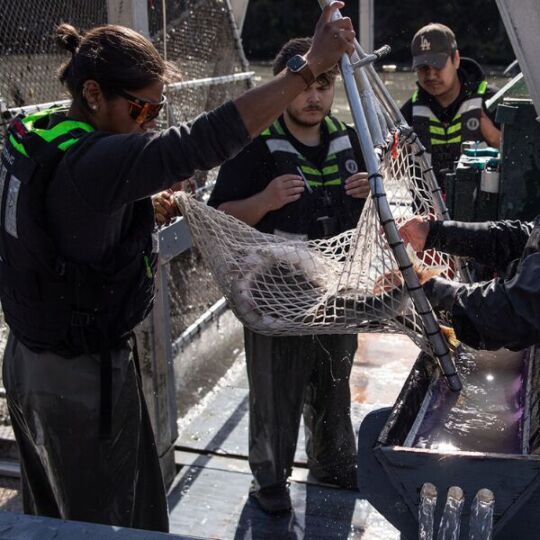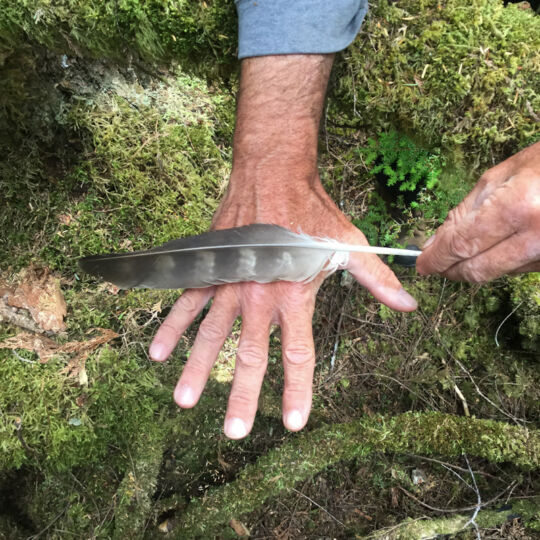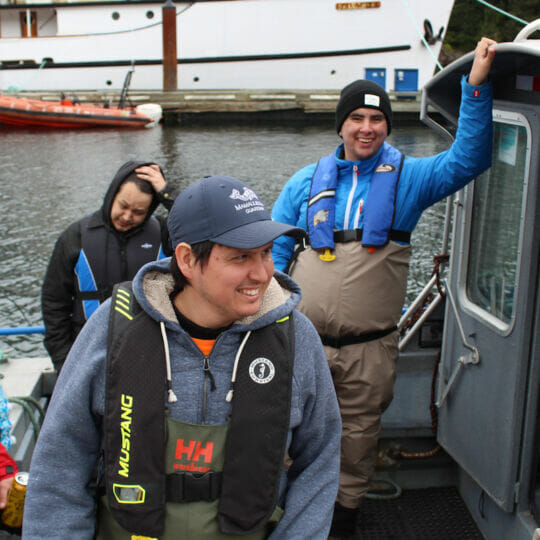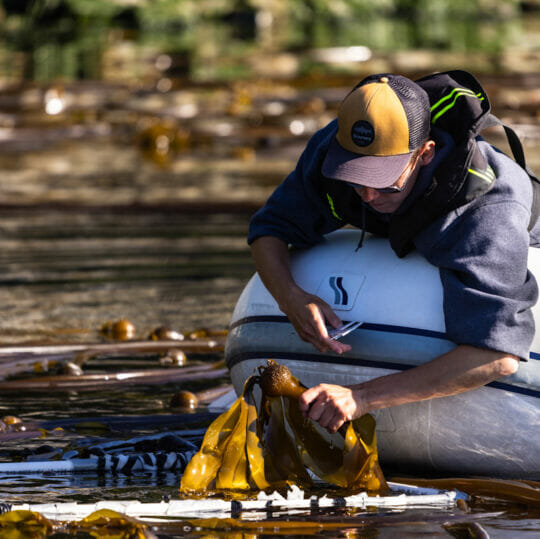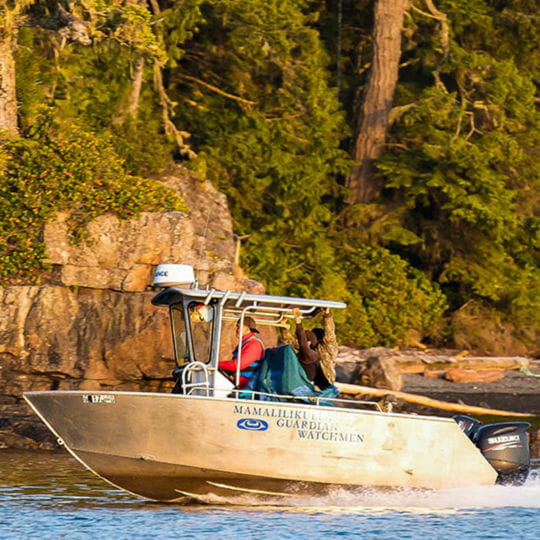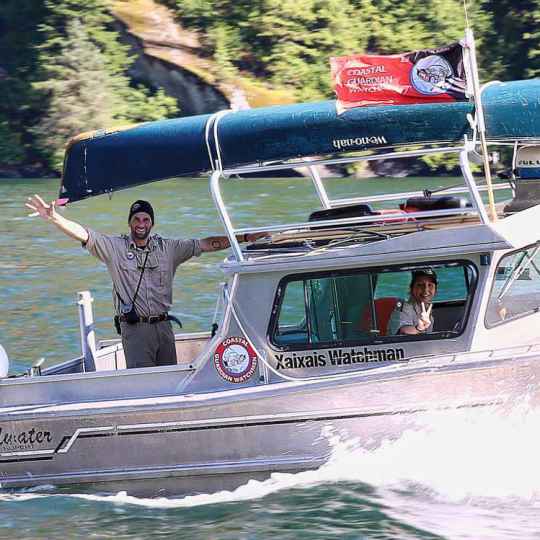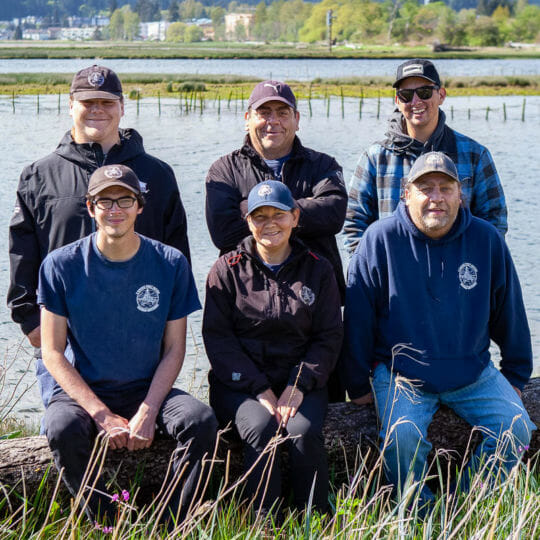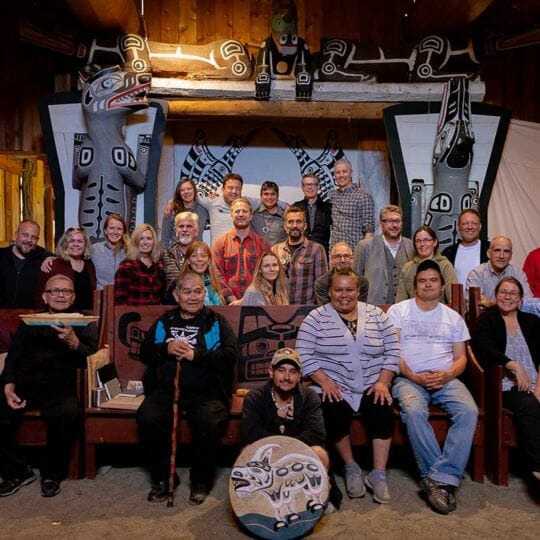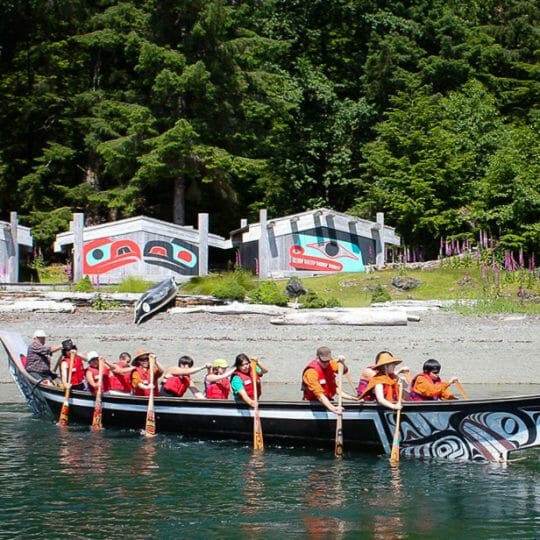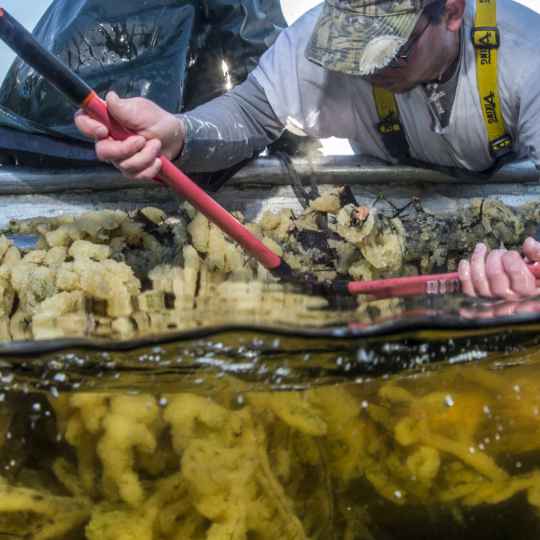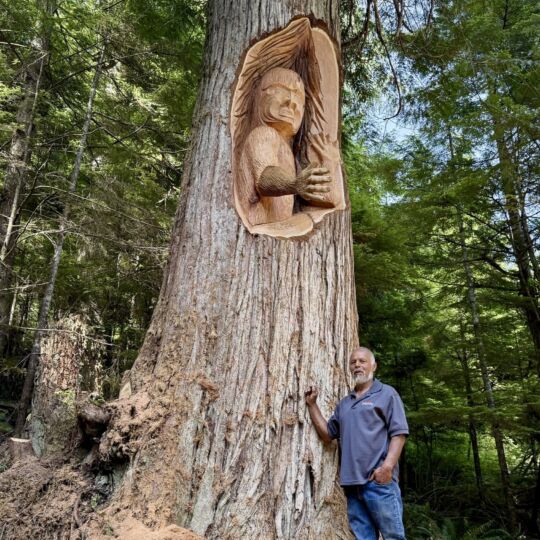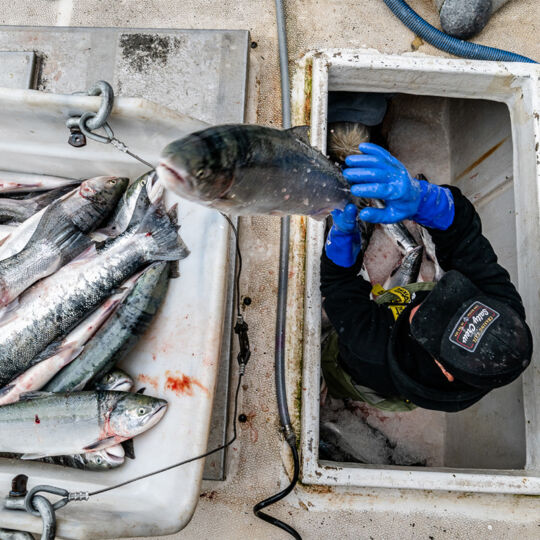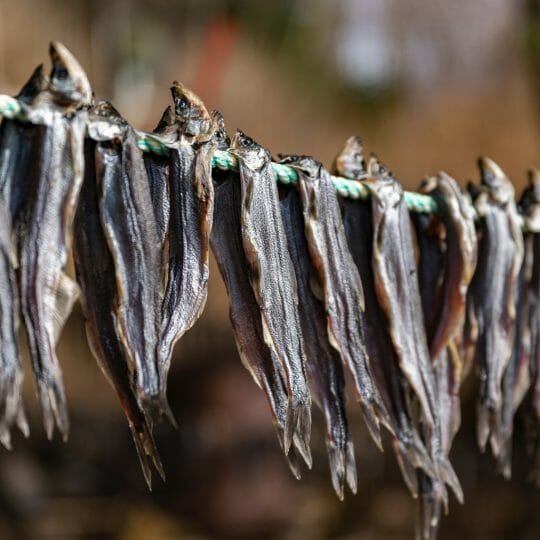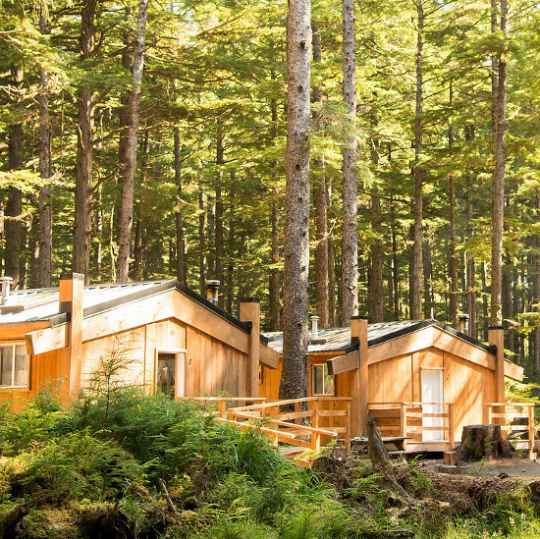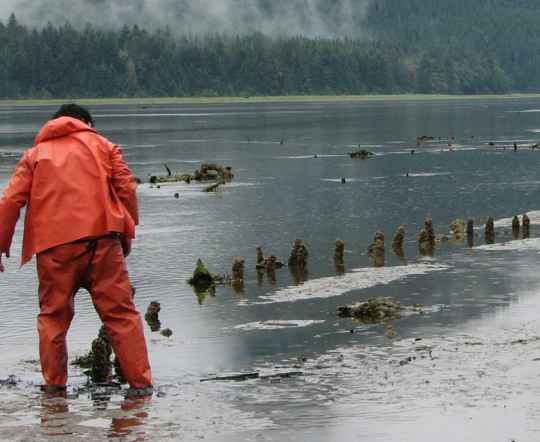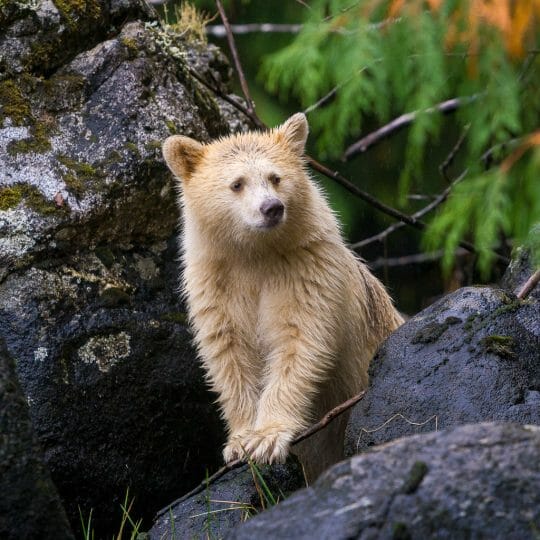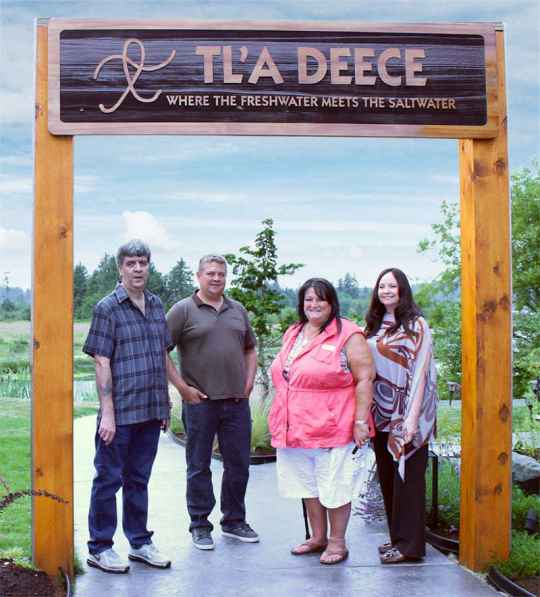Cultural Vitality
First Nations are revitalizing cultural traditions to ensure Indigenous knowledge and traditional stewardship practices are sustained for future generations.

First Nations in the Great Bear Rainforest and Haida Gwaii regions of British Columbia have rich and varied cultural traditions, including unique governance structures, oral histories, art, language, and intimate knowledge of their natural surroundings. First Nations are actively revitalizing their cultural traditions through programs that transfer knowledge from Elders to youth, protect and document oral histories, incorporate language and traditional place names, and support stewardship activities that leverage traditional ecological knowledge.
First Nations’ indigenous knowledge is central to all science and conservation initiatives in the Great Bear Rainforest, protecting the ecological integrity of the region while maintaining or enhancing communities’ cultural vitality. By working to sustain traditions, First Nations are supporting their community members’ multi-generational retention of unique knowledge that supports long-term stewardship of their lands, ocean, and culture.
Cultural Vitality Outcomes
First Nations are utilizing their unique indigenous knowledge as stewards to safeguard the ecological integrity of the Great Bear Rainforest and Haida Gwaii.
Traditional Stewardship
First Nations have led 150 traditional stewardship projects to protect and conserve resources and ecosystems in the Great Bear Rainforest and Haida Gwaii as an important element of projects supported through investments with Coast Funds.
Community Well-Being Impact
First Nations have been stewards of their lands for thousands of years, having established a wealth of what is often termed Traditional Ecological Knowledge (TEK). This knowledge includes in-depth understanding of local resource sustainability, harvesting sites, seasonal cycles, and cultural features throughout the region. Today, First Nations are ensuring that this knowledge is utilized to carefully manage resources and plan for the future of their communities and natural surroundings.
Our T'aalan Stl'ang Cultural Camp provides opportunities for children and youth to learn about Haida culture, biology, forestry, archaeology, and themselves at our remote camp facilities at Lepas Bay on the northwest coast of Haida Gwaii.
— April Churchill, Council of the Haida Nation
Related Stories
River Of Abundance: How Fishwheels Are Driving Nisg̱a’a Nation’s Salmon Stewardship
Along the Nass River, Nisg̱a’a Nation is using fishwheels annually to collect baseline data on salmon populations, helping to ensure food security and economic prosperity for their citizens.
A Feather in the Forest: Haida Researchers Race to Protect Endangered Stads K’un (Northern Goshawks)
Haida surveyors and stewardship staff, along with biologists and researchers, are racing to identify and protect critical old growth forest habitat for the last remaining stads k’un, a subspecies of Northern goshawk that’s unique to the island archipelago.
Ha-ma-yas Stewardship Network Supports Guardians, Collaboration
Through Ha-ma-yas, Na̲nwak̲olas member First Nations are pooling resources and increasing their access to training, fundraising, procurement, and data storage, and technical expertise.
Wei Wai Kum Guardians: In the Steps of Our Ancestors
For millennia, the Wei Wai Kum, part of the Laich-Kwil-Tach group of First Nations, have watched over and cared for the lands and waters in their territory. Today, the Nation’s Guardians combine traditional knowledge with scientific tools to carry out that responsibility in a modern way, bringing their findings back to decision makers.
Mamalilikulla Guardian Watchmen: Fulfilling Ancestral Responsibilities for the Benefit of Future Generations
The Mamalilikulla Guardians are re-asserting the Nation’s presence in their territories, conducting research and restoration, monitoring industrial and recreational activity, and protecting cultural assets. With the Nation’s 10-year stewardship vision, they are mapping a path forward to do even more.
Coastal Stewardship Network: Collaborative Monitoring and Protection of First Nations’ Lands and Waters
The Coastal Stewardship Network is supporting its member First Nations as they’ve established sophisticated monitoring programs and their analyses informing vital environmental and resource management decisions.
First Nations are enabling Elders to transfer cultural and stewardship knowledge to youth through a wide range of projects across the Great Bear Rainforest and Haida Gwaii.
Elders Working with Youth
First Nations have led 118 projects through investments with Coast Funds to facilitate the transfer of Elder knowledge to youth.
Community Well-Being Impact
First Nations have rich oral traditions and customs which make up the unique cultural identity of each Nation. First Nations are working to ensure that the lessons, history, language, and knowledge of their culture are passed from Elders to youth to maintain the traditions of each Nation into the future. The teachings of Elders and education of youth enables young people to become the future stewards of their territory and knowledge-holders of their Nation’s culture.
We have drumming practices that are open to everyone. The number participants are increasing every time, especially with youth joining. Knowing that they will grow up knowing our culture makes me very proud of the work that we do. Reviving our culture would not be possible without a supportive team, including contributions from Coast Funds.
— Dorothy Andrew, former Councillor, Xwémalhkwu (Homalco) Nation
Related Stories
River Of Abundance: How Fishwheels Are Driving Nisg̱a’a Nation’s Salmon Stewardship
Along the Nass River, Nisg̱a’a Nation is using fishwheels annually to collect baseline data on salmon populations, helping to ensure food security and economic prosperity for their citizens.
K’ómoks Guardians: Caretakers for the Land of Plenty
K’ómoks First Nation have stewarded the lands and waters of their vast territory since time immemorial. Today, that ancestral responsibility is carried out in large part by the K’ómoks Guardian department.
Nawalakw Healing Society and Culture Project: Embarking on a Journey of Cultural and Language Revitalization
At Hada River estuary, in the heart of Musga’makw Dzawada’enuxw territory, Chief Maxwiyalidizi (K’odi Nelson) is bringing an ambitious, hopeful vision to life. Nawalakw will offer cultural immersion and wellness programing supported through a world-class ecotourism operation.
Supporting Stewardship through Cultural Rediscovery on Haida Gwaii
Haida Rediscovery camps are revitalizing Haida culture and creating the next generation of leaders to care for and sustain the lands and waters of Haida Gwaii.
Return to the Homelands: Establishing the Gwa’sala-’Nakwaxda’xw Guardian Watchmen Program
After a forced relocation separated the Gwa’sala-‘Nakwaxda’xw Nations from their homelands, the creation of a Guardian Watchmen program is helping strengthen the Nations’ stewardship practices and cultural connections.
Heiltsuk Stewardship: Collaborating for Resource Management
The Heiltsuk Nation is ensuring that community voices are heard and important resources are protected through their stewardship work.
First Nations are protecting sacred cultural sites found in remote areas throughout the Great Bear Rainforest and Haida Gwaii.
Protecting Cultural Assets
First Nations have undertaken 112 projects through investments with Coast Funds to identify and protect sacred sites and cultural assets in their territories.
Community Well-Being Impact
Evidence of varied First Nations culture is found throughout the Great Bear Rainforest and Haida Gwaii. These sites, ranging from culturally modified trees, ancient pictographs, traditional harvesting areas, sacred sites, and old village sites are important to the cultural identity and spiritual well-being of First Nations. These physicals assets, as well as bodies of knowledge (including stories, beliefs, and songs), are documented and protected through conservation initiatives. By locating, monitoring, and recording information about cultural assets, First Nations are developing databases and management plans that incorporate protection of these sacred places for future generations.
For example, the five member nations of Ha-ma-yas Stewardship Network are working to define, identify, verify, and highlight potential protection measures for the rich, cultural and heritage resources within the members’ traditional territories. Protection of these sites is important for many reasons; of particular significance, is the way in which they connect current generations more deeply to the past with their ancestors. “I can’t stress enough how personally we take it when we find a burial cave ransacked,” says Gina Thomas a Guardian Watchmen with Tlowitsis First Nation. “I believe that most people would feel as we do, if they found their ancestors’ resting places disturbed or damaged.”
As a First Nations people, we want to protect our archaeological sites. The status quo used to be that we were left out – I’m really excited that times are changing.
— Gina Thomas, Tlowitsis Guardian Watchman
Related Stories
Kwakwa̱ka̱ʼwakw Carvers Uphold Millennia-Old Traditions
First Nations carvers are working with wilkw / k ̓ wa’x̱ tłu Large Cultural Cedar to create cultural works, like an ocean-going xwax’wa̱na, that celebrate the revival of traditions.
A Feather in the Forest: Haida Researchers Race to Protect Endangered Stads K’un (Northern Goshawks)
Haida surveyors and stewardship staff, along with biologists and researchers, are racing to identify and protect critical old growth forest habitat for the last remaining stads k’un, a subspecies of Northern goshawk that’s unique to the island archipelago.
Coming Home: Kwiḵwa̱sut’inux̱w Ha̱xwa’mis Invest in Solar Power, Infrastructure in Gwa’yas’dums
To revitalize the village of Gwa’yas’dums, the Kwiḵwa̱sut’inux̱w Ha̱xwa’mis First Nation has made generational investments in community planning, housing, renewable energy, and infrastructure.
Ha-ma-yas Stewardship Network Supports Guardians, Collaboration
Through Ha-ma-yas, Na̲nwak̲olas member First Nations are pooling resources and increasing their access to training, fundraising, procurement, and data storage, and technical expertise.
Mamalilikulla Guardian Watchmen: Fulfilling Ancestral Responsibilities for the Benefit of Future Generations
The Mamalilikulla Guardians are re-asserting the Nation’s presence in their territories, conducting research and restoration, monitoring industrial and recreational activity, and protecting cultural assets. With the Nation’s 10-year stewardship vision, they are mapping a path forward to do even more.
Reclaiming Control: How the Gwa’sala-’Nakwaxda’xw are Determining their Economic Future
Through in-depth community consultations, the establishment of the k̓awat̕si Economic Development Corporation reinvigorated the economic heartbeat of a community.
First Nations are strengthening access to traditional foods for health, culture, food security, and improving species’ abundance in the Great Bear Rainforest and Haida Gwaii.
Access to Traditional Foods
First Nations have led 155 projects through investments with Coast Funds that involved access to traditional foods through research, education and restoration work.
Community Well-Being Impact
First Nations have traditionally depended on the land and marine resources of their territory for food and have carefully managed these resources to prevent over-harvesting and depletion. Modern industry has threatened many of the traditional resource stocks of First Nations in the Great Bear Rainforest and Haida Gwaii, putting the food security of these communities at risk. First Nations are leading research and restoring species’ habitat to strengthen their communities’ access to traditional foods while sustaining harvestable resource stocks.
Guardian Watchmen monitoring helps to ensure the laws of the Nations are being abided by and these programs are helping to protect the populations of species important for Food, Social, Ceremonial use in our area.
— Chris Roberts, Regional Economic Development Coordinator, Nanwakolas Council Society
Related Stories
River Of Abundance: How Fishwheels Are Driving Nisg̱a’a Nation’s Salmon Stewardship
Along the Nass River, Nisg̱a’a Nation is using fishwheels annually to collect baseline data on salmon populations, helping to ensure food security and economic prosperity for their citizens.
Ts’msyen Nations Pilot a Flexible, Small-Scale Commercial Salmon Fishery
On the North Coast, Ts’msyen fishers are trialling a more flexible approach to commercial fishery management.
Ha-ma-yas Stewardship Network Supports Guardians, Collaboration
Through Ha-ma-yas, Na̲nwak̲olas member First Nations are pooling resources and increasing their access to training, fundraising, procurement, and data storage, and technical expertise.
The Saviour Fish: Protecting Nisga’a Connection to Oolichan
After Ḵ’alii Aksim Lisims (Nass River) oolichan were designated a species-at-risk, the Nisg̱a’a Lisims Government undertook a multi-year research project that would protect their connection to the culturally important fish.
Old Massett Village Council: Transforming a Haida Village Site
Old Massett Village Council’s promising new venture, Hiellen Longhouse Village, is providing ecotourism experiences of visitors to Haida Gwaii, creating jobs and training for locals, and hosting events that contribute to the Haida Nation’s ongoing cultural revitalization.
Kwiakah Nation: Restoring Phillips Arm through Research and Indigenous Knowledge
One of the smallest Nations in BC is working to restore and safeguard the unique marine areas in their territory.
First Nations are leading programs to revitalize Indigenous languages throughout the Great Bear Rainforest and Haida Gwaii.
Revitalizing Language
First Nations have undertaken 91 projects that increase knowledge about First Nations languages through investments with Coast Funds.
Community Well-Being Impact
First Nations speak many different dialects throughout the Great Bear Rainforest and Haida Gwaii. These languages hold the values, beliefs, and histories of their people, and are a vital tool to this pass knowledge between generations. Many of these languages have become endangered as fewer fluent speakers remain in communities. First Nations are actively revitalizing their languages through projects that teach language to youth, map traditional place names, and compile and digitize audio recordings of fluent speakers.
Language lessons were taught throughout each of the summer camps. The youth and Elders learned and practiced greetings, phrases, and names of animals and plants in our traditional language.
— Nancy Henderson, Former Administrator, Laich-Kwil- Tach Treaty Society
Related Stories
Ha-ma-yas Stewardship Network Supports Guardians, Collaboration
Through Ha-ma-yas, Na̲nwak̲olas member First Nations are pooling resources and increasing their access to training, fundraising, procurement, and data storage, and technical expertise.
Nawalakw Healing Society and Culture Project: Embarking on a Journey of Cultural and Language Revitalization
At Hada River estuary, in the heart of Musga’makw Dzawada’enuxw territory, Chief Maxwiyalidizi (K’odi Nelson) is bringing an ambitious, hopeful vision to life. Nawalakw will offer cultural immersion and wellness programing supported through a world-class ecotourism operation.
The Success of Spirit Bear Lodge: How a Remote, Community-led Business Became a Global Model for Ecotourism
Spirit Bear Lodge, owned and operated by Kitasoo/Xai’xais Nation, has become a successful model for conservation-based ecotourism. The Lodge has helped strengthen economic, conservation, and cultural well-being in the community of Klemtu.
Wei Wai Kum Nation: Seaside Cottages Boost Tourism In Campbell River
By expanding a reliably performing tourism business—Thunderbird RV Park—Wei Wai Kum Nation is investing in economic development to reach new markets, providing significant new sources of revenue and employment for its people.
‘Na̲mg̲is First Nation: Catalyzing Change for the Future of Salmon
By establishing Canada’s first land-based Atlantic salmon aquaculture facility with recirculating aquaculture system technology, the ‘Na̲mg̲is First Nation and its diverse partners are proving that environmentally sustainable salmon farming is possible.
Heiltsuk Stewardship: Collaborating for Resource Management
The Heiltsuk Nation is ensuring that community voices are heard and important resources are protected through their stewardship work.
